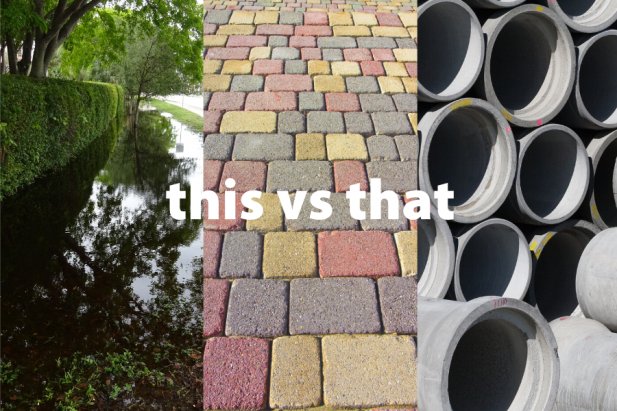
This vs. that: Comparing biofilters, porous pavement and underground retention
Here are the benefits of differing stormwater management options
With all you have to think about during site evaluation for your commercial construction project, there’s one item that can be overlooked: stormwater management. Managing stormwater runoff is no small consideration. Local, state and federal regulations require that stormwater runoff be treated before it enters any adjacent property, municipal storm sewer system and/or receiving waterway. So it’s important to compare the options you have at hand, alongside your biggest project priorities.
Depending on the scope of your project, the property size, topography, soil composition and the landscape, it’s likely one or more of these three options will rise to the top: biofilters, permeable pavement or underground retention.
The benefits of stormwater biofilters
Biofiltration provides a viable solution for managing stormwater runoff. Biofiltration is the process of improving water quality by filtering water through biologically influenced media. A typical biofilter consists of a vegetated swale or basin overlaying a porous, sand-based filter medium with a drainage pipe at the bottom. Stormwater is diverted into the biofilter, where it flows through dense vegetation and temporarily ponds on the surface before slowly filtering down through the sand-based filter media before exiting the biofilter through the drainage pipe.
Here are some of the considerations of biofilters.
- Biofilters improve water quality by filtering out pollutants, for receiving waters (local streams, rivers and lakes).
- Biofiltration systems can reduce erosion and flooding impacts by helping control the rate of stormwater runoff.
- Stormwater biofilters are a low-energy treatment technology.
- Biofilter design can be used in a wide variety of landscape settings, site conditions and catchment sizes.
- In times of high stormwater runoff flows, stormwater can pond before infiltration.
- Stormwater biofilters can collect litter and other debris, keeping them out of the runoff.
- Biofilters provide green space, even in urban settings, improving the aesthetics of the neighborhood, as well as a possible habitat for wildlife and local plants.
- Biofilters require regular inspection and maintenance to ensure no accumulation of an impermeable surface layer or accumulation of litter, as well as the health of vegetation cover and removal of weeds.
Benefits of permeable pavement
Permeable (also known as porous or pourus) pavement is a specific type of pavement with high porosity that allows stormwater runoff to pass through it into the ground below. Below are several considerations of porous pavement.
- Porous pavements can serve as both stormwater management infrastructure and hardscape, which provides a practical solution when space for other management efforts is limited.
- Porous pavement ranges from asphalt to concrete to paver blocks, plastic and more. They can provide full or partial exfiltration, or no exfiltration with a tanked system.
- Permeable pavement is more expensive than standard pavement, but the increased cost can be offset by eliminating the need for retention & infiltration basins and water collection areas.
- Porous pavement can help control pollutants and suspended solids by trapping them (via the soil or pavement.
- Permeable pavers can reduce runoff by releasing precipitation more slowly into the ground than traditional stormwater management solutions.
- Porous pavement may reduce your need for road salt in our harsh winters. One study showed permeable asphalt, for example, needs less than a quarter of the road salt needed for standard pavement.
- The overall strength of permeable pavement is generally lower than that of regular pavement, so it’s not recommended in areas of heavy use and/or heavy loading.
- Some types of permeable pavement require regular maintenance to ‘vacuum’ the suspended solids trapped in the pavement to prevent clogging of the pavement pores.
The benefits of underground retention
Not every construction site has ideal conditions for the two stormwater management options above. In that case, underground retention, also known as underground detention, may be the choice for you. Underground detention captures and stores stormwater runoff in large underground pipes or vaults, which is released in a controlled manner at pre-development rates.
- Underground detention is a space saver over other options. It is often a good stormwater management solution when land is expensive, or the project site has limited space available.
- When the terrain is steep or an area is restricted, underground retention offers a viable option for stormwater management.
- When it comes to making the most of the economic potential for your building, underground detention allows you to fully use the land you have while still following stormwater management regulations.
- Plastic, concrete and metal chamber options are available, with components that allow flexibility in the underground detention configuration.
- Underground storage detention is generally more expensive than surface stormwater management ponds and biofilters.
- Some sites have soil conditions that require pretreatment devices within the underground detention assembly, adding cost to the project.
The time to consider stormwater management is now
The ideal moment to mull over stormwater management options is long before a storm hits. Hopefully, these benefits and features of the differing types of stormwater management options are helpful as you choose the direction that’s right for your commercial construction. And when it’s time to tackle complex issues like stormwater management, having a design-build team on your side is key to making the right choices every step of the way. Contact us to learn more about how we can help you build the future of your business.